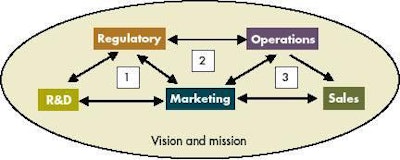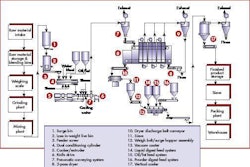
Imagine your favorite song, sonata or symphony. Hear the beauty and elegance of all the instruments working in harmony to create a composition that has the ability to evoke emotion or quiet the soul.
Suddenly that same musical piece digresses from the perfect; one or more key instruments are out of tune or missing altogether. Now a completely different sound is heard. For the inexperienced listener, this new piece might not be objectionable. For the experienced, however, it would be unbearable.
Successful product introduction should be more like the full musical experience. All pieces of the business enterprise need to work in concert to successfully launch a new product. The required components of the ensemble include a company's marketing, regulatory, research, operations/production and sales divisions. Each area has unique and specific obligations for the launch and product introduction. Communication between these functional units is the key.
The functionally connected organization
Virtually anyone in an organization can come up with a moneymaking or moneysaving idea. Employee empowerment is the key. Companies that encourage everyone in the organization to think about new products provide a powerful network of connectivity. From the salesperson in the field to the research scientist on the bench, the functionally connected enterprise with a clearly stated and understood vision and mission and open lines of communication will maximize its capacity to introduce new products and grow its business.
As the advertising and development costs associated with product launches have increased dramatically while product life cycles have shrunk, the rate of success for new products has decreased considerably (Dalens et al., 2002). Little insight has been provided on the role of functional business units and the importance of communication within the product launch process.
The launch process
Figure 1 shows how an idea might proceed from the product launch perspective. Since marketing is ultimately responsible for product launches in most companies, this department plays a central, linchpin role. Marketing acts as the mediator between the functional units. It's tasked with discerning what products the customer wants and communicating that to the organization, along with how to position and sell new products. Defining product qualities based on customer needs is one of the first steps in the product launch.
The functional units' interactions generally take the following path:
- The research and regulatory departments (square 1) are involved heavily in the initial stages of product launch.
- Next, regulatory and operations (square 2) must provide assistance and guidance in gaining regulatory approval and engineering the production process.
- Finally, operations and sales (square 3) finish the product development process as they manufacture, introduce and sell the product to the customer.
Marketing plays pivotal role
Miscalculations at the marketing stage are likely to doom the product to failure, no matter how well subsequent units execute. The marketing department must determine the ideal market segment in which to sell the product, applying the four P's of marketing: product, place, promotion and price.
Along with understanding what the market/customer wants, marketing personnel must have a strong technical understanding of the product. They must be aware of physical, chemical, biological or other constraints while establishing the essential characteristics of the new product. Marketing must also sift through and incorporate ideas coming from other functional units, determine potential, formulate a position statement and eventually create a full-blown market plan.
Finally, good marketers must know how to differentiate the product from the competition. The ultimate goal is to make the product number one or two in its product class.
Regulatory requirements
The regulatory department's focus is to work with the appropriate government agencies to obtain certificates of approval/registration for the new product. Often this is the last department to be consulted in the product launch. The experienced company knows, however, that consulting with regulatory personnel should be the first stop, since fulfilling requirements usually consumes significant time and money.
Managing expectations of senior management is crucial when government approval is required for a new product. Most companies have limited control over the approval process aside from response time to office actions requested by the agency. Providing realistic estimations of the current approval timelines as well as evidence of frequent contact with the agency can address concerns from senior management.
Research and development
Patented, proprietary products that have the potential to achieve number one or two in a given market are critical to maintaining an edge over competitors. The main role of research and development is to discover novel technologies and conduct relevant research to support a product launch.
In a commercial setting, designing experiments that support regulatory and marketing claims is essential to the product launch. Concomitant research to understand how the product works is often necessary and completed simultaneously with the efficacy studies.
Research studies can generally be divided into three areas:
- Basic research;
- Safety research;
- Clinical/efficacy study research.
If one set of experiments can fulfill the requirements of more than one of these research areas, both time and money can be saved.
Manufacturing's focus
The main role of the operation/production department is to build the product to specified parameters (as designed through the launch process) and make a quality product consistently and efficiently. Standard operating procedures, process controls (such as HACCP) and an understanding of good manufacturing procedures are all important. Generally, the operations department is also in charge of inventory control and production scheduling.
During product launch, changes to the manufacturing process are common; however, defining an established process to make the product within the allotted specifications is the ultimate goal. Early and excessive process optimization, with the otherwise admirable goal of reducing costs and improving final products, can result in costly delays in product launch. To ensure a successful and timely launch, validated quality control assays should be developed prior to final equipment placement and adjustment.
Sales: on the front lines
Members of the sales department are ultimately responsible for selling the new product to the customer base as defined by the marketing department, so a considerable amount of communication between these two departments is a must. During a product launch, a representative from the sales team should be involved in the later stages so he or she can anticipate and express the concerns of future customers. An experienced sales manager will ensure the sales team is on board with the concept and desirable features of the new product.
Outside of early market research focus groups and consumer test panels, the company's sales force is the first to see customer response to a new product at the grass roots level. Enlightened company management will encourage salespeople to report their observations of customer reactions, both positive and negative. This information can be used to improve the product, including highlighting ways to market it more effectively or in conjunction with other products.
Successfully launching a product is a difficult task. It requires the proper company focus, well-coordinated functional units and motivated employees. Communication between the functional units can assist in not only creating the best products but also moving them into the market in a timely manner.
.png?auto=format%2Ccompress&crop=faces&fit=crop&h=48&q=70&w=48)




.png?auto=format%2Ccompress&fit=crop&h=167&q=70&w=250)










